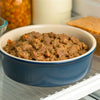Discovering What is the Best Wet Dog Food for Puppies: Elevating Your Pup's Feeding Experience
- Houndsy
Table of Contents
- Introduction
- Why Choose Wet Dog Food?
- Nutritional Needs of Growing Puppies
- Key Ingredients to Look For
- Best Wet Dog Food for Puppies in 2025
- Factors to Consider When Selecting Wet Dog Food
- Creating a Feeding Schedule for Puppies
- Bonus Tips for Feeding Your Puppy Wet Dog Food
- Conclusion
- Frequently Asked Questions (FAQs)
Introduction
Every puppy parent knows the joy and excitement that comes when a furry friend dives into their meal enthusiastically. Recent studies have shown that puppies can have unique dietary needs that require special attention, particularly when it comes to wet dog food. In fact, a survey conducted by the Pet Food Institute reveals that 70% of dog owners believe that the food they provide has a significant impact on their pet's health. With the abundant options available today, the paramount question arises: What is the best wet dog food for puppies?
From enhancing flavor to easy digestion, wet dog food is becoming increasingly popular among pet owners, especially for puppies who may struggle with the texture of dry kibble. In this blog post, we will explore what makes wet dog food a preferable choice for your developing pup, the specific nutritional needs that puppies require, and how we can help guide your decision through our insights and brand philosophy here at Houndsy.
As we delve further, we will cover various aspects, such as essential ingredients, factors to consider when selecting wet dog food, our top brand recommendations, and practical feeding tips. Ultimately, our goal is to help you provide a nourishing environment for your puppy, ensuring they grow into healthy, happy adults.
Why Choose Wet Dog Food?
Before we dive deep into the best options, let’s first understand why wet dog food has become a favored choice among pet parents. Here are some key reasons:
-
Higher Moisture Content: Wet dog food contains around 75-80% water, making it easier for puppies to stay hydrated, especially if they are less inclined to drink water regularly.
-
Easier to Chew and Digest: Soft food options are gentle on puppy teeth and gums, crucial during their teething phase. Many puppies struggle with digesting dry kibble, making wet food a welcome alternative.
-
Intensified Flavor: Wet food tends to have a richer aroma and flavor, making it more palatable for fussy eaters. This encourages puppies to enjoy their meals while also providing nourishing nutrition.
-
Gentle on Sensitive Teeth and Gums: For those delicate mouths, softer food can help prevent discomfort during mealtime, which is essential during the early stages.
-
Convenience: Wet dog food can be easier to portion, especially when measuring required servings directly from the can or pouch.
With these advantageous attributes, it's no surprise that many pet owners look to wet food as a primary or complementary source of nutrition for their growing puppies.
Nutritional Needs of Growing Puppies
Understanding what your puppy needs at different stages of growth is essential. Puppies require balanced nutrition that supports their rapid growth, which includes:
-
Calories: Puppies burn more energy than adult dogs due to their high metabolism. This necessitates a higher caloric intake as they develop.
-
Protein: Essential for muscle growth and development, protein should be a major component of your puppy's diet.
-
Fats: Healthy fats contribute to energy levels, skin health, and coat quality. Sources like Omega-3 and Omega-6 fatty acids play a significant role in overall well-being.
-
DHA: Docosahexaenoic Acid (DHA) is crucial for brain and vision development. This is particularly important for puppies as they mature.
-
Calcium & Phosphorus: These minerals are vital for developing strong bones and healthy teeth.
When selecting wet dog food, it’s crucial to find options labeled as “Complete and Balanced Nutrition for Puppies” that meet standards set by the Association of American Feed Control Officials (AAFCO). Always consult your veterinarian before making significant changes to your puppy's diet.
Key Ingredients to Look For
When we explore what is the best wet dog food for puppies, here are the primary ingredients you should prioritize:
-
High-Quality Proteins: Look for named meat sources like chicken, beef, or lamb as the first ingredient. Avoid vague terms like “meat by-products” or “meat meal,” which may contain lower-grade protein sources.
-
Healthy Fats: Essential fatty acids come from sources like chicken fat or fish oil. These ingredients promote skin health and sustain energy levels.
-
Whole Grains and Vegetables: While some puppies may do well on grain-free diets, other puppies benefit from the fiber and nutrients found in whole grains such as brown rice and oatmeal. Vegetables provide important vitamins as well as antioxidants.
-
Vitamins and Minerals: Look for foods that include a blend of essential vitamins (A, C, D, and E) and minerals to ensure comprehensive nutrition.
-
Unique Nutritional Additives: Ingredients like probiotics for gut health, glucosamine for joint support, and omega fatty acids for skin and coat health can offer additional benefits.
At Houndsy, we believe that the ideal product reflects our commitment to quality nutrition and exceptional design. Our flagship product, the Houndsy Kibble Dispenser, though primarily for dry kibble, embodies our ethos of elevating pet feeding routines.
Best Wet Dog Food for Puppies in 2025
Navigating the choices of wet dog food can be overwhelming. To streamline your search, we’ve compiled a list of some top-rated wet dog food brands for puppies that meet essential nutritional requirements:
1. The Farmer's Dog Chicken Recipe
- Nutritional Profile: Rich in protein, this wet food includes fresh chicken as its primary ingredient alongside vegetables.
- Pros: Human-grade ingredients, customized subscriptions, and no artificial additives.
- Best For: All breeds.
2. Ollie's Chicken Dish with Carrots
- Nutritional Profile: This premium option combines chicken and vegetables for balanced nutrition, with a focus on digestibility.
- Pros: Clear ingredient sourcing, highly palatable, and personalized feeding plans.
- Best For: Picky eaters.
3. Wellness Complete Health Puppy
- Nutritional Profile: Formulated by veterinarians and packed with protein and veggies, this formula provides whole-body health.
- Pros: Affordable without sacrificing quality, vitamins and minerals included.
- Best For: All puppy sizes.
4. IAMS Proactive Health Puppy
- Nutritional Profile: This classic offers wholesome chicken and rice, designed for balanced diets.
- Pros: Affordable and nutritious for a regular diet.
- Best For: General puppy feeding.
5. Royal Canin Puppy Formula
- Nutritional Profile: Tailored for specific breeds, this formula helps regulate growth and supports bone and joint health.
- Pros: Vet-recommended, specific formulations for different breeds.
- Best For: Breed-specific nutrition.
6. Purina Pro Plan Development Chicken and Rice Entree
- Nutritional Profile: Formulated with a higher fat content for palatability while including DHA for brain growth.
- Pros: Great for picky eaters; offers easy digestibility.
- Best For: Sensitive stomachs.
By focusing on quality, nutrient density, and specific needs of puppies, each of these brands shines as options for responsible pet owners.
Factors to Consider When Selecting Wet Dog Food
As you embark on the journey to find the right wet dog food for your puppy, keep the following factors in mind:
-
Breed Size: Large breed puppies may require food with controlled calcium levels to prevent developmental issues, while smaller breeds need more calorie-dense foods for energy.
-
Ingredient Quality: Always read the ingredient list; avoid foods with artificial preservatives, fillers, or vague meat by-products.
-
Vet Recommendations: Consulting your veterinarian helps tailor your selection to your puppy’s unique health needs.
-
Feeding Guidelines: Follow the feeding guidelines on the package to ensure you’re offering the right amount based on age and weight.
-
Assessing Reaction: Monitor your puppy’s reaction to a new food. Ensure they’re consuming it eagerly and are experiencing no adverse reactions.
Creating a Feeding Schedule for Puppies
Establishing a consistent feeding routine helps ensure healthy growth. Here’s a recommended feeding schedule based on the age of your puppy:
| Puppy Age | Meals Per Day | Notes |
|---|---|---|
| 6–12 weeks | 4 meals | Supports rapid growth |
| 3–6 months | 3 meals | Start adjusting portion sizes |
| 6–12 months | 2 meals | Transition to twice-daily feeding |
By adhering to a proper feeding schedule, puppies can develop a routine, feel secure in their environment, and thrive as they approach adulthood.
Bonus Tips for Feeding Your Puppy Wet Dog Food
Implementing a feeding strategy goes beyond simply selecting quality food. Here are some extra tips to enhance mealtime:
-
Use Puzzle Feeders: Spread wet food into slow feeders or puzzle toys to stimulate your puppy mentally and prevent fast eating.
-
Balance with Dental Chews: Combine wet food with dental chews to maintain oral health.
-
Clean Food Bowls Regularly: To prevent the buildup of bacteria, clean your puppy’s food bowl after each meal.
-
Refrigerate Leftovers Promptly: Store the unused portion of wet food properly to avoid spoilage.
-
Monitor Weight and Growth: Weigh your puppy weekly to ensure they are growing at a healthy rate. Adjust portions as necessary.
At Houndsy, we believe the daily rituals of feeding can be both nourishing and beautiful. The Houndsy Kibble Dispenser, for instance, promotes consistent feeding practices that benefit both pet and owner.
Conclusion
Choosing the right wet dog food for your puppy is crucial for their nutritional journey. As we’ve explored in this guide, several factors come into play from breed size and ingredient quality to establishing a feeding routine.
Every choice you make now establishes a foundation for their health and happiness in adulthood. Remember, a well-fed puppy is a happy puppy, and investing in quality nutrition is an investment in their very future.
We encourage you to reflect on your own feeding routines—what might you change to enhance your puppy's mealtime experience? If you're looking for more guidance or inspiration in pet feeding convenience, check out the Houndsy Kibble Dispenser and elevate your pet's feeding experience today!
Frequently Asked Questions (FAQs)
What is the best wet dog food brand for puppies? There are several excellent brands for wet dog food, including The Farmer's Dog, Ollie, Wellness, and Royal Canin, all of which cater to the nutritional needs of growing puppies.
Can I feed my puppy only wet dog food? While wet food can be a primary source of nutrition, it's best to consult your vet to ensure that your puppy receives a balanced diet with appropriate caloric intake.
How do I know if my puppy likes a wet food brand? Monitor their eating habits. If your puppy consumes the food eagerly without hesitation, it’s likely a favorite. Consider trying different flavors and textures if they show disinterest.
Is wet food better than dry food for puppies? Wet food offers benefits like increased palatability and hydration, but some pups thrive on a dry diet. It’s essential to find what works best for your specific puppy’s needs.
How long does canned puppy food last once opened? Once opened, wet dog food should be stored in the refrigerator and used within 3-5 days. Always check for any spoilage before serving.












